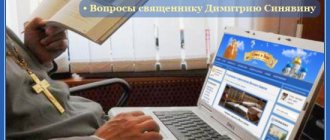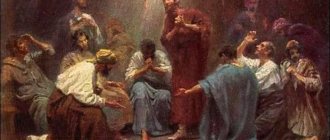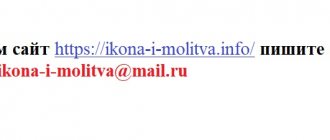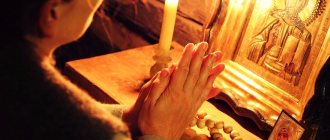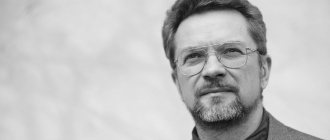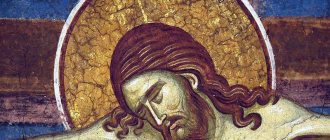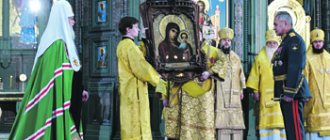Lessons of the century: repression of the clergy in 1937
Monument to priests and laity - victims of Soviet power in the city of Shuya, Ivanovo region near the bell tower of the Resurrection Cathedral
In July of this year, we remember another sad anniversary in the history of our fatherland: 80 years ago, directives were issued that led to mass executions and repressions. Nowadays, one can increasingly hear voices in defense of Bolshevism and its particular manifestation - Stalinism. Some call Stalin an “effective manager,” while others argue, no less, that there was practically no persecution of the Church: churches were closed only because people stopped going to them, and priests lost material support from the state. But history, as they say, is a stubborn thing. And forgetting its lessons is fraught with the need to repeat what was forgotten, now from one’s own experience. It seems that another attempt to remember the events of 80 years ago and their causes will not be superfluous. But due to the vastness of the topic, I would like to pay primary attention to the fate of the clergy and issues of faith.
Nowadays, one can increasingly hear voices in defense of Stalinism
In order to correctly assess the situation that developed in 1937, one should first turn to the year 1918, more precisely, to the first Soviet Constitution adopted that year. According to this Constitution, not all citizens of the USSR had access to full civil rights. A significant number of people were classified by this Constitution as persons deprived of their rights, to whom the name “disenfranchised” was assigned. This category included “a) persons who resort to hired labor for the purpose of making a profit; b) persons living on unearned income, such as interest on capital, income from enterprises, income from property, etc.; c) private traders, trade and commercial intermediaries; d) monks and clergy of churches and religious cults; e) employees and agents of the former police, special corps of gendarmes and security departments, as well as members of the reigning house in Russia; f) persons recognized in accordance with the established procedure as mentally ill or insane, as well as persons under guardianship; g) persons convicted of mercenary and defamatory crimes for a period established by law or a court verdict”[1].
As for depriving religious people of voting rights, their circle has been increasing over the years. In 1925, “psalm-readers, cantors, muezzins, etc.” were added to the dispossessed monks and priests. support staff." At the same time, a significant reservation was made that religious ministers of various ranks “are deprived of voting rights only if the main source of their existence is income from the performance of religious rites”[2].
“On March 15, 1926, a meeting of the Organizing Bureau of the Central Committee was held, at which J.V. Stalin sharply condemned the election instructions of the All-Russian Central Executive Committee of 1925, Fr. On his initiative, it was decided to create a commission under the leadership of V. M. Molotov, which was supposed to revise the instructions and eliminate the provision on “expanding the circle.” By the elections of 1926–1927. a new instruction was prepared “On the elections of city and rural Soviets and the convening of congresses of Soviets.” The instruction was approved by the Presidium of the All-Russian Central Executive Committee on November 4, 1926.”[3].
With this instruction, the number of categories of disenfranchised, including clergy, was significantly increased. In addition, the above-mentioned reservation was completely eliminated. Since that time, “ministers of religious cults of all faiths and persuasions, such as: monks, novices, priests, deacons, psalm-readers, mullahs, muezzins, rabbis, biys, kazis, cantors, shamans, bucks, priests, pastors, reciters and others names performing the corresponding listed duties” are deprived of voting rights “regardless of whether they receive remuneration for the performance of these duties”[4].
Restoring lost rights to these documents also becomes more difficult. “A minister of a religious cult could be restored to voting rights only if he renounced the priesthood; this had to happen publicly, for example, by publishing a statement of renunciation in a newspaper. In this case, it was necessary to have 5 years of socially useful work experience”[5].
The deprivation of voting rights itself was not a simple formality, but led to a whole chain of events that turned the life of the disenfranchised into an unceasing series of troubles and sorrows. “Dismissal from work; exclusion from trade unions and cooperatives, and this entailed the inability to receive goods and products under the rationing system in 1929-1935; the eviction of “disenfranchised” people from the apartments they occupied in municipal buildings in cities, then even from large cities during the latter’s “cleansings” in the 1920-1930s; a significant increase in the tax burden and even the introduction of special taxes for “disenfranchised” people, for example, military taxes, since the children of “disenfranchised” were not drafted into the regular Red Army; exclusion of “disenfranchised” children from senior secondary schools, technical schools and universities”[6] - this is an incomplete list of the social consequences of deprivation.
Vyacheslav Molotov (left) and Joseph Stalin in Yalta
Over time, persecution by the authorities only increases, taking on new forms of persecution of those undesirable: “In 1929-1930. “purges” took place in government institutions in order to remove disenfranchised and other “socially alien” persons from them. Hospitals and courts, housing and tax departments, and other structures had to pursue discriminatory policies towards them. A secret government decree in August 1930 prohibited the provision of work to disenfranchised people and other employees who had lost it as a result of the recent purges; it was proposed to “send them to logging, peat mining, snow removal, and only to places where there was an acute shortage of labor.” [7].
The consequence of such measures was not only the extreme difficulty of life (probably, it would be more correct to say, survival) of those dispossessed in Soviet reality, but also a quantitative increase in this group of the population of the USSR, whose rights, in mathematical language, “tended to zero.”
As a percentage of the total number of voters in the RSFSR, the disenfranchised were: 1924 - about 1.6%, in 1926 - 4.5%, in 1927 - 7.7%. “In other republics, the number of deprived people, as a rule, was even higher. In 1929, it made up 11.8% of voters in Ukraine, 13.7% in Uzbekistan. In general, according to published data, in the USSR in 1929, 8.6% of the adult population were deprived of voting rights, while in 1927 – 7.7%”[8].
But all of the above was not enough for the Soviet government, and from 1925 it began to deprive all members of the disenfranchised family of voting rights. Subsequently, this category of disenfranchised became one of the most widespread[9].
State persecution of deprived families had a devastating effect on their families. There were common cases when the priest himself, in order to make life easier for his wife and children, officially divorced his wife, meeting with the family in secret.
Sometimes the wife tried to show her independence from her deprived husband: “For example, the wife of the psalm-reader Anna Aleksandrovna Pokrovskaya, who lived in the village. Mostovsky, Shatrovsky district, in her application indicated that she is a member of a trade union, works as an assistant accountant: “I earn my own piece of bread.” But such attempts did not always lead to the desired result: “Nevertheless, Pokrovskaya’s petition was rejected; she failed to prove her financial independence from her psalm-reading husband”[10].
The saddest picture was that of children abandoning their parents. “So, a student of the Tyumen Agricultural College Tarkov Semyon Nikolaevich writes in his statement: “...The material connection with his father (the director of the church folk choir, not a psalm-reader) is completely broken, and I live in an apartment with him only because there were no places in the college dormitory …""[eleven].
The dispossessed person became a real outcast in Soviet society
Thus, the dispossessed person became a real outcast in Soviet society. Deprived of voting rights and, as a consequence, the opportunity to find a permanent job and a more or less stable source of income, the deprived person was forced to constantly balance on the brink of survival, which was not always possible for those who had the status of a citizen in the hungry revolutionary years and the years that followed. The forced break with their family complicated their situation to the extreme.
These people did not fit into the poster image of the builders of communism. The attitude of the young Soviet state towards them could be illustrated by the motto of the pagan Roman emperors of the first centuries of Christianity: “Christianos non esse”[12]. The only difference is that the Bolsheviks, in comparison with the Romans, significantly expanded the circle of people who did not have the slightest right to exist. This circle included everyone who at least somewhat disagreed with the general line of the party, as well as those who belonged to classes and estates for whom there were no places in the “bright future”, and simply those who, so to speak, did not lucky (“they cut down the forest and the chips fly”).
The attention of the Soviet authorities to the clergy was especially close. Just as in ancient Israel a harlot and the son of a harlot could not enter into the community of the Lord (Deut. 23:2), so in the USSR neither the priest nor his relatives had any hope of legal existence in Soviet society.
By 1936, the country's supreme power had probably come to the conclusion that two decades under the leadership of the Communist Party and Comrade Stalin personally had sufficiently united Soviet society, melting its citizens into a new type of human race, later ironically called homo sovieticus. This belief was reflected in the new Soviet Constitution of 1936, called “Stalinist”. One of the achievements of this Constitution was Fr. Now it is difficult for us to imagine with what enthusiasm this Constitution was received by many. All former dispossessed people and members of their families, who until now seemed to be on the edge of an abyss, accustomed to living in constant fear of a new round of repression, deprived of the right to protect themselves and loved ones from state despotism, suddenly receive full civil rights, including the right to vote and be elected. They receive hope not only for life, but for life without deprivation, humiliation and threats. Such prospects could not but inspire the most rosy expectations among the recent outcasts. Naturally, the priests, who represented a category of people doomed by the Soviet regime to complete disappearance, also took heart.
Updaters
Here, for example, is a letter from I.V. To Stalin of the renovationist clergy of the Vyazma diocese on the adoption of the constitution of 1936: “The clergy of the Vyazma diocese, headed by their Archbishop Paul (orientation of the Supreme Church Council), with a feeling of genuine joy and filial devotion expresses to you, the wisest of people, their deepest gratitude for the gifts given to us the rights set out in the immortal historical document - the GREAT STALIN CONSTITUTION. We, like all citizens of a socialist state, see and feel in this document the amazing, brilliant victories won by our wonderful country under your brilliant leadership. The day of approval of the new Constitution for us, hitherto disenfranchised, has appeared and will remain until the end of our lives a truly bright day of triumph, a bright day of joy for ourselves and for all the people inhabiting our homeland and warmed by your fatherly care, unprecedented in the history of mankind. We sincerely assure you, Joseph Vissarionovich, and the Soviet Government that in all our activities we will justify the great trust placed in us by the party and government of the Soviet Union, and each of us who has encroached directly or indirectly on undermining the power of our dear homeland, where people breathe so freely , will doom himself to deserved punishment, and there is and will not be a place for this in our ranks. Glory to you, Great Architect of human happiness, for endless years. May your genius illuminate the path for all humanity! Glory to our Soviet Government! LONG LIVE THE GREAT STALIN CONSTITUTION!”[13]
The renovationist clergy is, of course, a separate issue. The emergence of Renovationism was initiated by the Soviet government, and subsequently this schism was supported by the state, but by the 1930s, support faded, and repression affected Renovationists no less than those who remained faithful to the Church. Nevertheless, enthusiasm for the new constitution was great among all sections of the recent dispossessed.
But, as subsequent events showed, the joy was more than premature.
At the beginning of 1937, a population census was conducted in the country of the Soviets, in which, after the Stalinist edition, a clause on religion appeared. Moreover, the questionnaires were not anonymous. All answers were personal, indicating the details of the respondent and his address.
However, the census results caused outrage among the authorities. The census was called sabotage, its results were declared invalid and classified, and the census leaders were shot or imprisoned. Historians name two main reasons for this attitude of the authorities towards the census results.
The first reason is the identified catastrophic decrease in population as a result of repression, forced collectivization and the terrible famine of 1932-33. Meanwhile, the very fact of famine in the country was kept silent.
The second reason is that according to the census results, the majority of residents of the atheistic state (56, 17%) turned out to be believers. “In addition, some believers, in a climate of terror, when people were arrested simply for keeping a Bible at home, avoided answering.”[14]
Constitution of 1936
But the Constitution of 1936 declares the full rights of all Soviet citizens, including universal suffrage, which they could exercise already in December 1937 in the elections to the Supreme Soviet.
It became obvious that people with beliefs alien to communists, people who had not been ground in the ideological meat grinder of Bolshevism, open and hidden enemies of Soviet power, would take part in the elections to the central body of state power. But what to do? You can’t shoot, imprison, or deprive the majority of the country’s rights! And the answer suggested itself: most of it is impossible, but the most active part is possible. And who is best suited for such a sample? Of course, the recent “disenfranchised”.
The matter in this case was greatly facilitated by the fact that local authorities had lists of those deprived of their rights. Moreover, these lists were publicly available, since they were supposed to be published a week before the next elections[15]. The lists were posted on walls, doors, notice boards of local authorities (for example, village councils) or published in local newspapers. However, the census carried out with detailed information about religious affiliation and exact address data of those “enumerated” helped in identifying the “enemy element”[16].
And so, on July 3, 1937, a document appears signed by the Secretary of the Central Committee of the All-Union Communist Party of Bolsheviks I. Stalin, addressed to “Comrade. Yezhov, secretaries of regional committees, regional committees, the Central Committee of the National Communist Parties" and containing the following instructions: "The Central Committee of the All-Union Communist Party of Bolsheviks invites all secretaries of regional and regional organizations and all regional, regional and republican representatives of the NKVD to register all kulaks and criminals who returned to their homeland in order to so that the most hostile of them would be immediately arrested and shot in order to administratively carry out their cases through troikas, and the rest, less active, but still hostile elements, would be re-registered and sent to the regions on the instructions of the NKVD.
The Central Committee of the All-Union Communist Party of Bolsheviks proposes to submit to the Central Committee within five days the composition of the troikas, as well as the number of those subject to execution, as well as the number of those subject to deportation”[17].
At first glance, it may seem that there is no talk of clergy here. But the fact is that the so-called “church members” were previously subject to prosecution under Article 58 of the Criminal Code of the USSR as enemies of Soviet power, “anti-Soviet”, “counter-revolutionaries”. For this reason, the term “criminals” here must be understood to include all clergy and clergy who have served various prison sentences. We find confirmation of this in the Operational Order of N.I. Yezhov dated July 30, 1937, where among the “contingents subject to repression” are “the most active anti-Soviet elements from former kulaks, punitive forces, bandits, whites, sectarian activists, churchmen...” [18] In addition, the preamble of the order states: “ The materials of the investigation into the cases of anti-Soviet formations establish that ... many formerly repressed clergymen and sectarians settled in the village”[19].
According to the decision of the Central Committee of the All-Union Communist Party (Bolsheviks) and the directive of Stalin quoted above, in the operational order of the People's Commissar of the NKVD, all those repressed were divided into two categories: the first - firing squad, the second - condemned to imprisonment:
“All repressed kulaks, criminals and other anti-Soviet elements are divided into two categories:
a) the first category includes all the most hostile elements listed above. They are subject to immediate arrest and, upon consideration of their cases in troikas, to EXECUTE.
b) the second category includes all other less active, but still hostile elements. They are subject to arrest and imprisonment in camps for a term of 8 to 10 years, and the most malicious and socially dangerous of them are subject to imprisonment for the same terms in prisons as determined by the troika.”[20]
The consideration of cases by “troikas” was an expedited sentencing procedure[21].
Taking into account data received from the field, an approximate number of persons subject to repression for each category was determined. From one hundred to five thousand people were subject to execution in each of the 64 subjects of the USSR, plus 10,000 from the NKVD camps. The operation was ordered to “begin on August 5, 1937 and be completed within four months”[22], i.e. a week before the elections to the Supreme Soviet of the USSR scheduled for December 12, 1937.
Instead of the promised rights, the state left behind them the only “right” - the right to die.
As for the priesthood, according to the most reliable data, in 1937, 80,000 representatives of the clergy, clergy and laity who suffered for their faith were shot[23]. Since the mass executions of “church members” in 1937 were associated with the events described above, it is easy to calculate that from August to November of this year, every month the state shot about 20,000 of its own citizens for their faith, most of whom were clergy. If we remember that not even a year has passed since these people officially received full constitutional rights, then the sophisticated cynicism of the Soviet government “and Comrade Stalin personally” appears before us in all its terrifying ugliness. Instead of the promised rights, the state left behind them the only “right” – the right to die[24].
Everything was unimportant, except for one thing - belonging to the clergy or open confession of one’s faith. Such a person was terrible for the Soviet authorities, even with severe disability.
Fedor Mikhailovich Ivanov
A resident of Tobolsk, Fyodor Mikhailovich Ivanov, fell ill with articular rheumatism at the age of 13, which resulted in paralysis of both legs. Fedor devotes his life to prayer, contemplation of God and spiritual help to his neighbors. The year 1937 comes. Fedor is unfoundedly accused of preparing “for a bandit uprising against Soviet power”[25]. NKVD officers come for him.
“Who’s at home? – asked the military man.
“Everyone is at home,” answered Evgenia Mikhailovna.
- And good. We are taking Fyodor Ivanov.
Evgenia went into Theodore’s room, the military man behind her.
- Fedya, hello. Guests have arrived in large numbers.
“Well, well, I’m always happy to receive guests,” the ascetic answered meekly.
“We’re taking you away,” said the military man.
- Well, since you have such an order, then I submit to the authorities.
Theodore lay in bed all these years in a long shirt, and his mother Elizabeth went to get a suit, the only one he had, prepared for death, but she was stopped:
- It won’t be needed, it won’t be needed.
NKVD firing squad, 1936.
The stretcher was prepared. An NKVD officer approached and said:
“Well, let’s put it down,” and he asked Theodore in a low voice: “How can we take you?”
“And you make your hands like this,” he showed, “into a lock, and throw them behind my head.” And let the second one hold your legs.
His legs did not bend, they were like sticks, but they did not lose sensitivity. One of them grabbed him by the legs, but, immediately feeling the enormous strength of the ascetic, he screamed in fear and threw Theodore. The sister ran up, grabbed the patient’s legs and shouted at them:
- Monsters! What do you do with a sick person? What kind of rush are you in?
“Don’t worry,” Fyodor said lovingly and comfortingly, “it’s bad for you to worry.”
When Fyodor was finally placed on a stretcher, he prayed and said:
– My dear mother and sister, don’t wait for me and don’t bother; they won't tell the truth anyway. Pray. Don't cry for me and don't look for me!
It is known that in prison Theodore was not asked anything, was not taken to interrogations, and the investigator did not come to the cell. And none of the 136 residents of Tobolsk, arrested at the same time as him, were also asked about Theodore. The entire accusation was based on a certificate given by the chairman of the Tobolsk district council. On September 11, the UNKVD troika sentenced him to death. Theodore was shot in the Tobolsk prison, on the territory of which he was buried.”[26]
Extreme old age was also not a reason even to commute the sentence.
Hieromartyr Metropolitan Seraphim (Chichagov)
Metropolitan Seraphim (Chichagov) has lived in retirement since 1933. “The last months of the Metropolitan’s life in Udelnaya were calm and serene. The saddest thing was old age and the diseases associated with it. He suffered greatly from hypertension, shortness of breath, and recently from dropsy, so he could hardly move and hardly left the house. During the day, spiritual children came to him, others came from St. Petersburg; Metropolitans Alexy (Simansky) and Arseny (Stadnitsky) visited Vladyka, coming to meetings of the Synod. In the evenings, when everyone had left, the Metropolitan sat down at the harmonium and played well-known sacred music for a long, long time or composed it himself. And then peace and tranquility spread everywhere. The life of grace was coming to an end. There was little left...
The Metropolitan was arrested in the late autumn of 1937. He was 84 years old, and for the last few days he had felt completely ill, so the NKVD officers found it difficult to take him away in a prisoner’s car - they called an ambulance and took him to Taganskaya prison. The interrogation was a formality. On December 7, the NKVD Troika decided to shoot Metropolitan Seraphim.”[27]
The fact that the priest had many children, as most of those endowed with holy orders were in those days, did not stop the authorities.
Priest Tikhon of Arkhangelsk and Mother Khionia gave birth to 18 children, of whom nine survived. “The day of August 9, 1937 turned out to be warm. The entire family of the owners, the priest, mother and children, were in the house, but due to the warmth of the day, the door to the street was wide open. Suddenly a car stopped near the house, people in uniform got out and headed towards the house. Upon entering, one of them immediately approached Father Tikhon and asked: “Are there any weapons?” - "Eat! - answered the priest. – Cross and prayer!”
The NKVD officers scattered around the house and began turning things over. One of them climbed behind the stove, took a pistol out of his holster and then, coming out from behind the stove, showed it to the military who had arrived with him and said: “Here is his weapon!”
Standard accusations invented by the authorities of “terrorist intentions against the party and government” and “counter-revolutionary connections” about. Tikhon did not admit it, but despite this, “On October 4, 1937, the NKVD Troika sentenced Tikhon’s father to death. Those sentenced to death were executed outside the city of Lipetsk. Before the execution, an NKVD officer asked Father Tikhon: “Won’t you renounce?” - “No, I won’t renounce!” - answered the priest. Archpriest Tikhon Arkhangelsky was shot on October 17, 1937 and buried in a now unknown common grave.”
Khionia Ivanovna did not remain free for long. Soon, for excessive curiosity about the fate of her husband, she was arrested and sentenced to eight years in the camps for “anti-Soviet activities,” which she, however, did not recognize. Mother was happy about the arrest: “I might see Father Tikhon there!” But she did not have to see her beloved husband in this life, because Fr. Tikhon was shot before her arrest. Seven years later she was released due to an incurable illness, and a year later she died.[28]
One of the results of the Communist Party policy described above was that “by 1938, the church organization was basically destroyed. In 1937 alone, more than 8 thousand churches were closed, 70 dioceses and vicariates were liquidated, and about 60 bishops were shot.”[29]
The above facts show that the executions and repressions of 1937 were the logical conclusion and apogee of the growing persecution of the Soviet regime against the undesirable and, in particular, against the clergy. And if it were not for the God-allowed war with Germany, then there is no doubt that the Soviet repressive machine would have destroyed any open forms of churchliness in Soviet society. If we remember that the majority of government officials who participated in the repressions themselves sooner or later became victims of repressions or conspiracies, then the picture emerges as truly catastrophic.
Supporters of the rehabilitation of Stalin and the restoration of Bolshevism would like to wish to carefully familiarize themselves with the historical materials of the era of Stalinism. Otherwise, we are in danger of repeating the events of a century ago with their consequences.
Archpriest Mikhail (Trukhanov)
In conclusion, I would like to quote the words of Archpriest Mikhail Trukhanov, an elder confessor who spent 15 years of his life in Soviet camps and exile: “Stalin’s death found me here in Aban. I remember the funeral meeting at the district health department. The chief doctor spoke. She burst into tears so much that her sister (a radiologist) came to the rescue, but she also burst into tears by the end of the performance...
I stood at the entrance door near the lintel and thought: what kind of nonsense filled the hearts of Russians, crying about the hero of bloodthirstiness, who, undoubtedly, surpassed all the murderers, destroyers and desecrators of Christian shrines in the entire past history.
The Russians, who rejected God, left the Church, and did not protect the Tsar, the Anointed of God, turned out to be worthy of such rulers! And now Russians are sincerely crying! This means that the “Soviet” way of life will not yet be finished, by which (its lies, debauchery, atheism) the Antichrist himself is preparing for the entry into his ferocious rights.
Of course, even such thoughts are terrible for those who cry for the one who abandoned them, the forerunner of the Antichrist.”[30]
Boris Rauschenbach
Physicist, one of the founders of Soviet cosmonautics, academician, Lenin Prize laureate
The anniversary celebrations dedicated to the 1000th anniversary of the Baptism of Rus' in June 1988 took place with unprecedented pomp for the Soviet Union. There was even a ceremonial meeting and concert at the Bolshoi Theater in the presence of the entire Moscow elite and representatives of all religious denominations. Except that Gorbachev, as the General Secretary of the CPSU Central Committee, was not there due to ideological etiquette. But his wife was there as a representative of the Cultural Foundation.
But back in late September 1986, at a meeting of heads of departments of social sciences, Ligachev, the second secretary of the Central Committee, scolded the Russian creative intelligentsia for “flirting with God” and “speaking in favor of a tolerant attitude towards religious ideals, in favor of a return to religious ethics.”
As a result, a year before the anniversary, everyone was silent about it - writers, humanities scientists, and cultural figures. Only Komsomolskaya Pravda promised its readers to completely defeat the churchmen and began publishing a series of atheistic articles, which, by the way, also said nothing about the upcoming memorable date.
And suddenly, in August 1987, the magazine “Communist” published an article by academician Boris Raushenbach “The Millennium of the Baptism of Rus'”, which was immediately reprinted by numerous foreign media, including the magazine “UNESCO Courier”. To top it all off, in November the session of the UNESCO General Assembly calls for celebrating the 1000th anniversary of the Baptism of Rus' “as the largest event in world history and culture.” The Soviet leadership inevitably had to comply.
In February 1988, after Rauschenbach’s report “The Theology of the Icon” at an international theological conference in Leningrad, Soviet newspapers and magazines vying with each other published his interviews. And in the spring, Gorbachev already met with the Patriarch and the Synod, discussing the program of the upcoming celebrations.
Boris Rauschenbach in the Nikolo-Kuznetsky Church
They brought equipment and workers to the Moscow Danilov Monastery and managed to restore it in time for the anniversary, spending about 100 million rubles of state budget money instead of the planned twenty. There they even managed to open a real monastery with 40 inhabitants, as well as three churches, a Sunday school and a public library. Although several years before this, the authorities tried to completely cancel the decision to restore it from ruins, taken by Brezhnev. As a result, they decided that there would be no monastery there - only a church administrative center.
Now the celebration of the 1000th anniversary of the Baptism of Rus' is spoken of as a turning point in the relationship between the Church and the state.
And Academician Rauschenbach... It was in 1975, when his book “Spatial Constructions in Old Russian Painting” was published in the Soviet Union, the scientific community was shocked. Like this? A world-famous physicist, one of the founders of astronautics, who created the scientific school of space navigation, developed control systems for the Luna, Venera, Vostok spacecraft and the Mir orbital station, and suddenly... a “reverse perspective” of the Russian icon.
For some it was simply eccentricity. But there were also those who were made to think deeply by the fact that a scientist who had devoted his entire life to rockets, a man whose life was literally saved by mathematics in the Stalinist camp, who took up the theory of spacecraft control when there was no trace of a satellite, suddenly began build mathematical models that explain the Trinity of God.
After 1988, Academician Rauschenbach’s passion for theology no longer shocked anyone. Just like the title of one of his last works - “...facing the Holy Trinity.”
Alexey Losev
Philosopher, translator, writer, professor, Doctor of Philology, laureate of the USSR State Prize, author of more than 800 scientific works.
Students of the Moscow Pedagogical Institute, where Losev worked for more than forty years, studied ancient languages with him, not suspecting that their half-blind professor in an “old-regime” academic cap was devoted to a separate article in the Italian Encyclopedia of Philosophy back in 1957, calling his philosophical ideas brilliant. And that his cap is nothing more than the monastic cap of a secret monk.
Alexey Fedorovich and his wife and assistant took secret monastic vows in June 1929. Before being tonsured, Valentina Mikhailovna wrote in her diary: “Martyrdom awaits for confessing Christ. Either you have to go into the desert, or to the feat of confession.”
A year later, his “Dialectics of Myth” was published, which led both spouses to prison, and then to a camp.
How else could this have ended? Circles of militant atheists began to be organized throughout the country back in 1923, and in 1925 the Union of Atheists of the USSR appeared. Under the slogan “Through godlessness - to communism,” there was a total brainwashing in the country. Anti-religious literature was published in millions of copies. The creation of state anti-religious workers' universities began - special educational institutions for training personnel for the decisive attack on religion.
Newspaper "Atheist", 1929
And then suddenly some philosopher publishes a book in which he proves that the myths of “proletarian ideology” are no different from the “capitalist” myths, that communists are creating their own myth about the possibility of a religionless society. That the slogans circulated by newspapers and magazines about the intensification of the class struggle as socialism is built give rise to the myth of a terrible world in which “the ghost of communism wanders across Europe,” “the hydra of the bourgeoisie bares its teeth,” “bandits in tailcoats” and “cannibals in mitres” scurry about everywhere. , everywhere there are “dark forces”, “dark reaction”, “a black army of obscurantists”, and in this darkness the “red dawn of a world fire” rises.
Of course, they could not forgive such a demarche in the country of militant atheism. In 1922, Losev’s friends from the Religious and Philosophical Society in Memory of Vladimir Solovyov and the Berdyaev Free Academy of Spiritual Culture, who were capable of formulating such thoughts, were simply loaded onto the “Philosophical Steamer” and sent into exile. In 1930, Losev, as a “class enemy, reactionary and Black Hundred”, was sent to build the White Sea-Baltic Canal, and his wife was sent to Altai. And only through the incredible efforts of Ekaterina Peshkova, the wife of Maxim Gorky, who headed the Political Red Cross (at that time already called “Assistance to Political Prisoners”), they were released three years later - “due to shock work” and due to disability (in the camp Losev is almost blind). They were even allowed to live in Moscow.
But Losev was forbidden to engage in philosophy. But they couldn’t stop thinking. Moreover, in the camp he learned to “write” his scientific works in his head. And of the activities officially permitted to him, he chose the most natural one for himself - teaching. While still a student, in an atmosphere of pre-revolutionary decadence, he, the grandson of an Orthodox archpriest, compiled notes on the theory of religious education, looking for an approach to the youthful soul.
How fruitful this approach turned out to be can be judged by Professor Losev’s students. Among them are philosopher, philologist, cultural historian, biblical scholar Sergei Averintsev, Byzantine scholar Archpriest Valentin Asmus, philosopher, philologist and translator Vladimir Bibikhin, physicist, philosopher and theologian Sergei Khoruzhy. It is largely thanks to them that in the country of total ideological control in the 1960s and 1970s, the intelligentsia flocked to the Church.
People who knew Losev closely said that he was like an elder to them. That he always felt a person and gave such advice that it was impossible not to follow. When students gathered at his house, he asked curious questions: “Is this some kind of seminar you are having there? On what days? Can I come?" They answered: “For mercy, what seminar? Losev is studying Greek and Latin with graduate students.” Although denunciations were still written against him - both in the 1970s and in the 1980s - they say that he has an ideologically harmful influence on students.
A. A. Takho-Godi and A. F. Losev at the Open Day. 1984
He was allowed to publish his works only after Stalin's death. He managed to participate in the preparation of the third edition of the “Philosophical Encyclopedia”, the encyclopedia “Myths of the Peoples of the World” and the “Philosophical Encyclopedic Dictionary”; his monographs on Hellenic-Roman aesthetics and the aesthetics of the Renaissance were published. But the circulation of his book about Vladimir Solovyov in the popular series “Thinkers of the Past” was completely arrested in 1983.
Meanwhile, Losev’s early books were remembered and reflected upon—and not only by philosophers, but also by theologians. Back in 1928 in Paris, Semyon Frank wrote in the article “The New Russian Philosophical System” that Losev’s books testify: “Despite the terrifying pressure of Marxism, philosophical creativity in Soviet Russia did not freeze.” And Archimandrite Euthymius (Wendt), the same age as the philosopher, went with the Volunteer Army to the Balkans, and then in Paris became a student at the Theological Institute. St. Sergius and a priest, in 1971 he published an article in which he put Fr. Sergius Bulgakov and Alexei Losev, calling them “teachers of the Church.”
In recent years, Alexei Fedorovich could not go to church - he was completely blind. He confessed and received communion secretly at home. He knew church services by heart. He fasted strictly. Worked every day, seven days a week. He lived with one thought: to be in time. Have time to express what life did not allow you to do on time.
Losev died in his ninety-fifth year, in 1988, on the eve of the celebration of the 1000th anniversary of the Baptism of Rus', on the day of remembrance of his beloved saints - Cyril and Methodius. And two days before that, he dictated his last text - “The Tale of Cyril and Methodius.”
